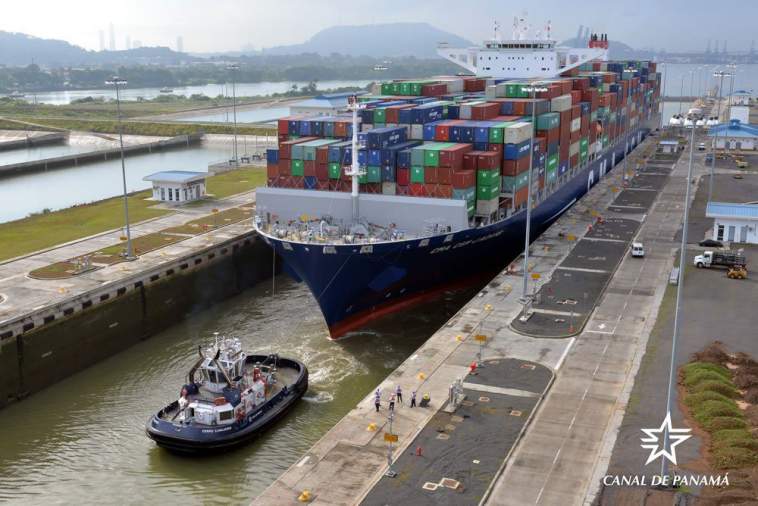(gCaptain) Federal Reserve Chair Jerome Powell keeps careful track of employment levels, wages, consumer prices and numerous other metrics to see where the US inflation rate may be headed in the next year.
He might also want to keep an eye on water levels at Gatun Lake.
That’s the lake that feeds the locks in the Panama Canal with the fresh water needed to raise vessels as they pass from the Pacific Ocean to the Atlantic. But a severe drought has caused water levels in the lake to drop far below normal, resulting in weight limits and rising surcharges for vessels traversing the canal.
It’s also unnerving economists and supply-chain experts. Just as the world’s delivery bottlenecks are easing, Panama’s drought and worrisome weather patterns elsewhere threaten to revive some of the chaos of 2021, when a surge in shipping costs and consumer demand resulted in shortages of goods, helping to drive US inflation to a four-decade high.
If Gatun Lake levels keep falling as forecast, the market reaction will be higher shipping rates and a scramble to find alternative routes from Asia to the US, logistics experts said.
The drought also risks undermining the Fed’s battle to get the rate of inflation closer to its 2% target, said Jonathan Ostry, an economics professor at Georgetown University and a former International Monetary Fund official.
US inflation is gradually slowing according to the Fed’s preferred gauge, yet at 4.7% remains “at a level that is very uncomfortable for central banks,” Ostry said. “And the last thing they need is to tune out unfavorable news about shipping” as they did in 2021, which he called “borderline malpractice.”
The Panama Canal Authority is forecasting a July 31 water level of 78.2 feet (23.86 meters), beating the previous all-time low of 78.3 feet reached in May 2016 and far below the five-year average of 84.9 feet for July.
Making matters worse, an El Niño system is building in the western Pacific Ocean and is expected to upset normal weather patterns by the end of this year. While this can cause heavy rainfall in some regions, in Panama it typically means severe drought and higher than normal temperatures. Erick Córdoba, the head of the canal’s water department, in an interview said El Niño could mean a longer dry season for Panama in 2024, which would also affect water levels.
The drought already is making it more expensive to move goods. The canal authority has steadily reduced draft levels– how low a vessel can sit in the water – since February. To comply with lower drafts, large ships must lighten their loads by taking fewer containers overall or by dividing the same amount of cargo among more containers. Either way, the result is higher price tags for consumer and industrial goods that move through the canal. Some ocean carriers also began charging per-box container fees on June 1 in response to the draft limits.
Cargo rates will rise on other routes, too, if low water levels force shippers to find alternatives—especially if the peak shipping months of August and September, when retailers build inventory ahead of the holiday shopping season, is stronger than expected.
One bright spot is that maritime shipping costs and demand levels have declined sharply from last year. A glut of inventory-clogged warehouses and worries about the broader economy put the brakes on new orders. Still, large volumes of cargo are moving, with demand at about the same level as in 2019, according to Peter Sand, who is chief analyst for Oslo-based Xeneta AS, which tracks shipping rates.
While the Panama Canal has struggled with water shortages since before a 2016 expansion that allowed giant container vessels, called Neo-Panamax ships, to pass through, this year’s drought started earlier and is projected to be more severe than previous ones. Ricaurte Vásquez, the Panama Canal Authority’s administrator, in a statement said May was the driest May since 1950 and that if things get really extreme this year, the canal could be forced to cut the number of ships it transits each day to between 28 and 32, from as many as 36 now.
The draft limit for the larger vessels is now 44.5 feet, down from the normal 50 feet, and is set to fall again to 44 feet on June 13. That could result in a 40% reduction of cargo, according to Nathan Strang, head of ocean freight at Flexport Inc., a freight forwarder.
If water levels hit 78.2 feet as the canal authority predicts, the maximum draft will decline to 43 feet, reducing cargo capacity even more.
Even if Panama’s drought doesn’t ruin Christmas the way supply-chain snarls did in 2021, it could still nudge up the rate of inflation. And if conditions continue to worsen, the Federal Reserve, which looks set to pause interest-rate hikes at its next meeting on June 13 and 14, may have to resume its campaign to get rising prices under control, especially with inflation proving to be stickier than many had hoped. Consumer goods are seen as contributors.
The 2021 bottlenecks, which caused a six-fold spike in shipping costs from pre-Covid levels, increased inflation by more than 2 percentage points in 2022, said Ostry, the Georgetown economist. “Shipping costs can be a canary in the coal mine for future inflation spikes” since it takes 12 to 18 months for those costs to feed through the economy.
His research shows a 20% increase in shipping costs boosts the inflation rate by 0.15 percentage point a year later. Though shipping rates are lower now than during the pandemic, such an increase could undermine the Fed’s effort to tackle inflation and shouldn’t be ignored, the economist said.
So far, the draft limits at the Panama Canal look similar to 2019 when the last serious drought occurred, but whether it will get worse, stay the same or improve in the next few months isn’t clear, said Zera Zheng, head of business resilience consulting at shipping company A.P. Moller-Maersk. “To me the pattern looks different.”
Weather patterns worldwide are off, Zheng said. “If you put Panama’s low water levels into the big picture, actually you see that it’s just one signal and globally you will probably see more and more coming.”
Zheng points to the Rhine River in Europe, where high temperatures and scarce rainfall last year caused delays and increased shipping costs for commodities. Already this year, areas of Southeast Asia have experienced their hottest days ever recorded, and low water levels in the Yangtze River, a vital inland freight route in China, are also impeding shipping, she said.
Scientists say that climate change is causing Panama to see more extreme hot weather and milder cool weather. According to the UN Intergovernmental Panel on Climate Change, heat waves were longer by 2.6 additional days, on average, between 2016 and 2020, compared with the 1985 to 2005 period. Yet scientists say it’s unclear if Panama’s droughts will worsen since it’s caught between Caribbean weather conditions, which bring more rain, and the Pacific, which is drier.
The Panama Canal is one of the fastest and least expensive ways to move grain and other agricultural commodities, as well as consumer goods from China and other Asian manufacturing hubs, to US ports.
About 5% of annual global maritime trade passes through the canal’s locks. Among the Neo-Panamax users of the canal in April, container vessels made up 45% of traffic, followed by carriers of liquefied petroleum gas, dry bulk and liquefied natural gas.
LNG carriers aren’t as affected by the recent draft changes because the vessels typically sit only about 37 feet in the water, according to canal spokesman Octavio Colindres. But any bottlenecks are a cause for worry with US LNG export expansions coming online in the next five years.
Because of the war in Ukraine, LNG shipments that normally went through the canal to Asia have declined as producers divert supplies to Europe to replace Russian gas. But in the long term, the canal is important as production increases, said Fred H. Hutchison, chief executive officer of LNG Allies, the US industry’s trade group, who called on the canal to begin efforts to expand.
If LNG vessels must avoid the Panama Canal because of bottlenecks or rising costs, the alternatives would mean longer routes around the Cape of Good Hope at the southernmost tip of Africa or through the Suez Canal, lengthening a voyage by weeks.
“Although there are alternatives, the canal is critical for LNG and other cargo,” Hutchison said. “We believe that all stakeholders need to begin working with Panama on another expansion. The last expansion took a decade, and the next will probably take that long – or longer. So let’s get on with it.”






